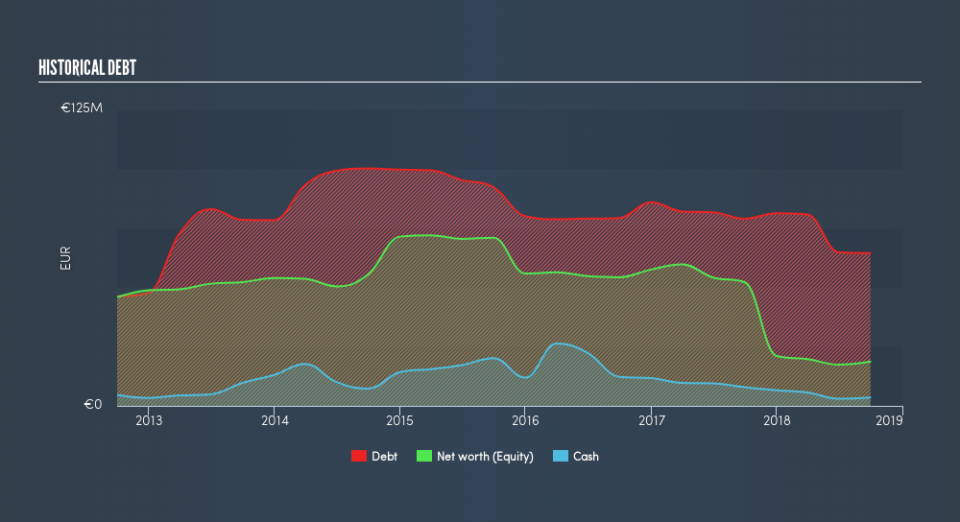Does TerniEnergia (BIT:TER) Have A Healthy Balance Sheet?

Some say volatility, rather than debt, is the best way to think about risk as an investor, but Warren Buffett famously said that 'Volatility is far from synonymous with risk.' So it seems the smart money knows that debt - which is usually involved in bankruptcies - is a very important factor, when you assess how risky a company is. As with many other companies TerniEnergia S.p.A. (BIT:TER) makes use of debt. But is this debt a concern to shareholders?
When Is Debt Dangerous?
Generally speaking, debt only becomes a real problem when a company can't easily pay it off, either by raising capital or with its own cash flow. If things get really bad, the lenders can take control of the business. However, a more frequent (but still costly) occurrence is where a company must issue shares at bargain-basement prices, permanently diluting shareholders, just to shore up its balance sheet. Having said that, the most common situation is where a company manages its debt reasonably well - and to its own advantage. The first thing to do when considering how much debt a business uses is to look at its cash and debt together.
See our latest analysis for TerniEnergia
How Much Debt Does TerniEnergia Carry?
You can click the graphic below for the historical numbers, but it shows that TerniEnergia had €64.4m of debt in September 2018, down from €102.4m, one year before. However, because it has a cash reserve of €3.52m, its net debt is less, at about €60.9m.
How Healthy Is TerniEnergia's Balance Sheet?
The latest balance sheet data shows that TerniEnergia had liabilities of €116.6m due within a year, and liabilities of €14.0m falling due after that. On the other hand, it had cash of €3.52m and €15.9m worth of receivables due within a year. So its liabilities total €111.1m more than the combination of its cash and short-term receivables.
This deficit casts a shadow over the €17.6m company, like a colossus towering over mere mortals. So we definitely think shareholders need to watch this one closely. At the end of the day, TerniEnergia would probably need a major re-capitalization if its creditors were to demand repayment. When analysing debt levels, the balance sheet is the obvious place to start. But you can't view debt in total isolation; since TerniEnergia will need earnings to service that debt. So if you're keen to discover more about its earnings, it might be worth checking out this graph of its long term earnings trend.
Over 12 months, TerniEnergia reported revenue of €54m, which is a gain of 46%. With any luck the company will be able to grow its way to profitability.
Caveat Emptor
Despite the top line growth, TerniEnergia still had negative earnings before interest and tax (EBIT), over the last year. Its EBIT loss was a whopping €7.2m. Reflecting on this and the significant total liabilities, it's hard to know what to say about the stock because of our intense dis-affinity for it. Sure, the company might have a nice story about how they are going on to a brighter future. But the reality is that it is low on liquid assets relative to liabilities, and it burned through €4.8m in the last year. So is this a high risk stock? We think so, and we'd avoid it like an anti-vaccine zealot with an obvious case of measles. For riskier companies like TerniEnergia I always like to keep an eye on the long term profit and revenue trends. Fortunately, you can click to see our interactive graph of its profit, revenue, and operating cashflow.
When all is said and done, sometimes its easier to focus on companies that don't even need debt. Readers can access a list of growth stocks with zero net debt 100% free, right now.
We aim to bring you long-term focused research analysis driven by fundamental data. Note that our analysis may not factor in the latest price-sensitive company announcements or qualitative material.
If you spot an error that warrants correction, please contact the editor at editorial-team@simplywallst.com. This article by Simply Wall St is general in nature. It does not constitute a recommendation to buy or sell any stock, and does not take account of your objectives, or your financial situation. Simply Wall St has no position in the stocks mentioned. Thank you for reading.

